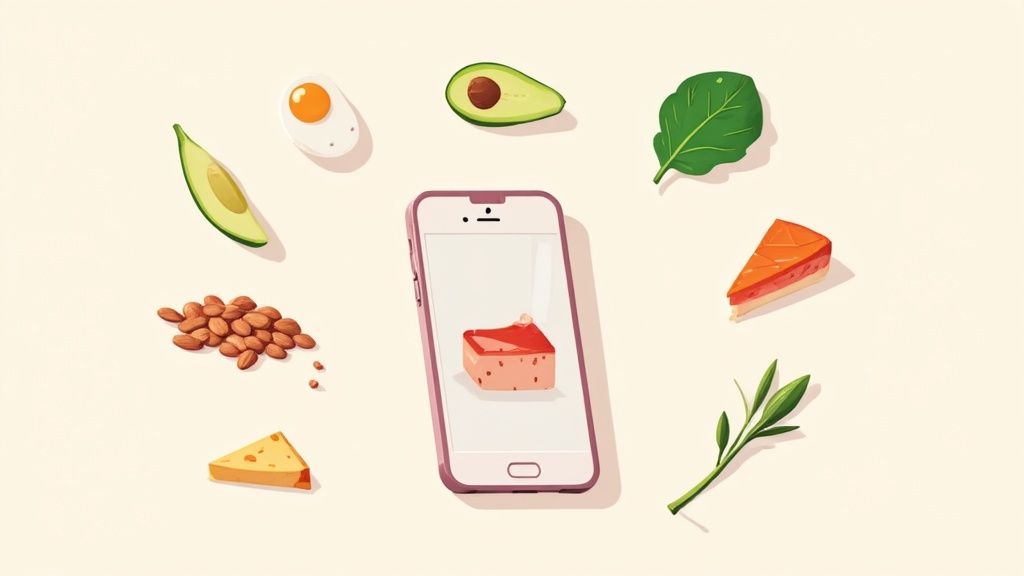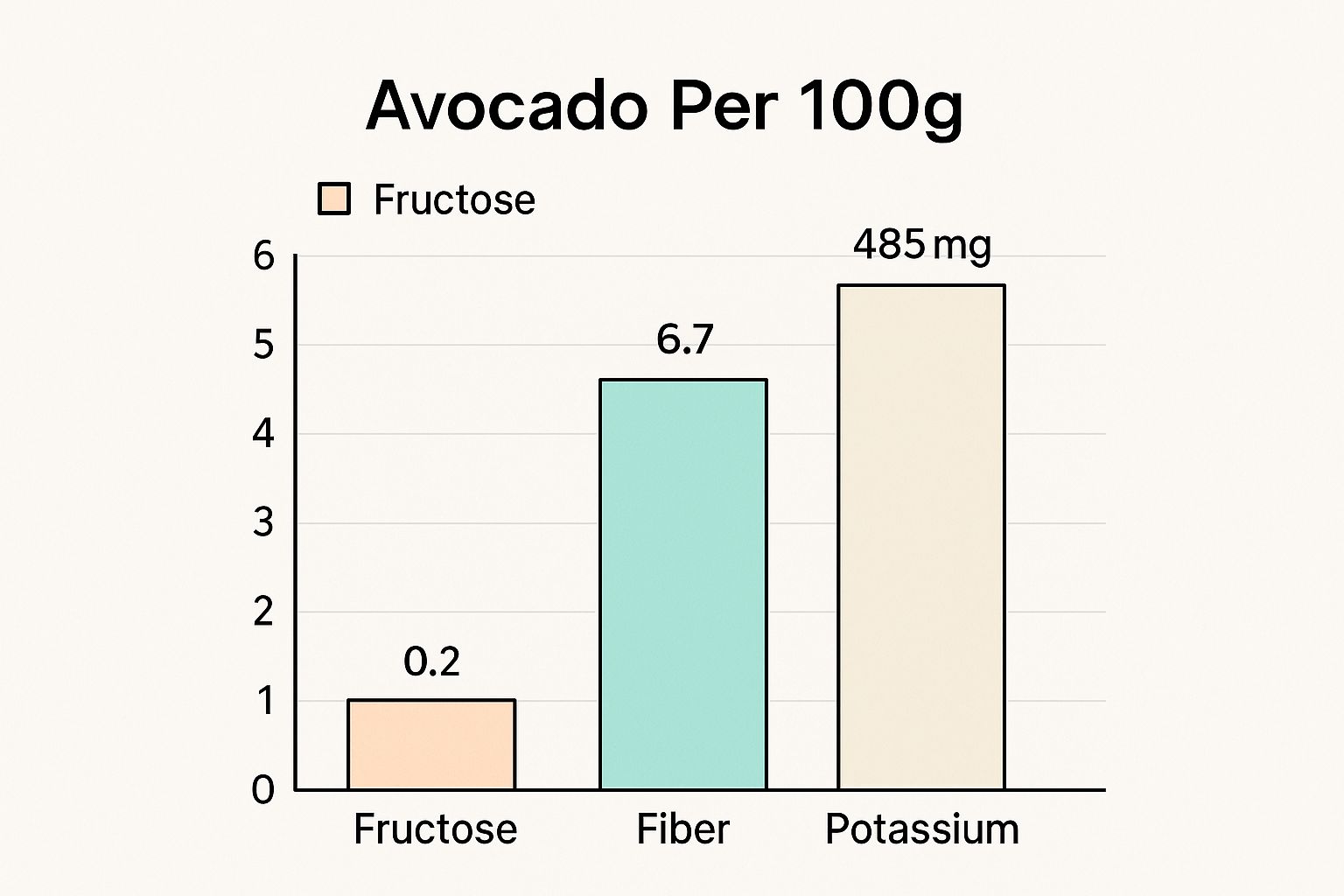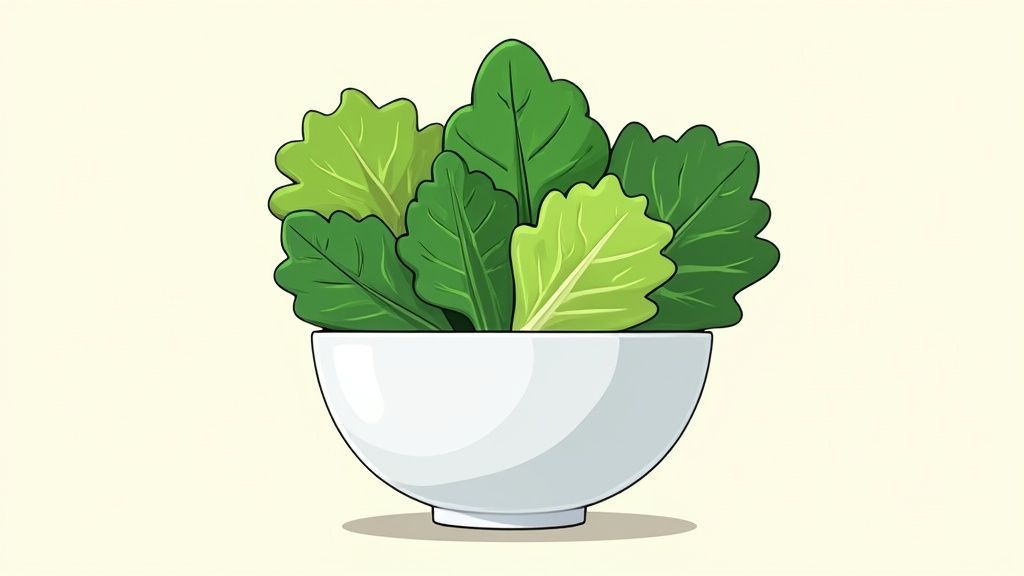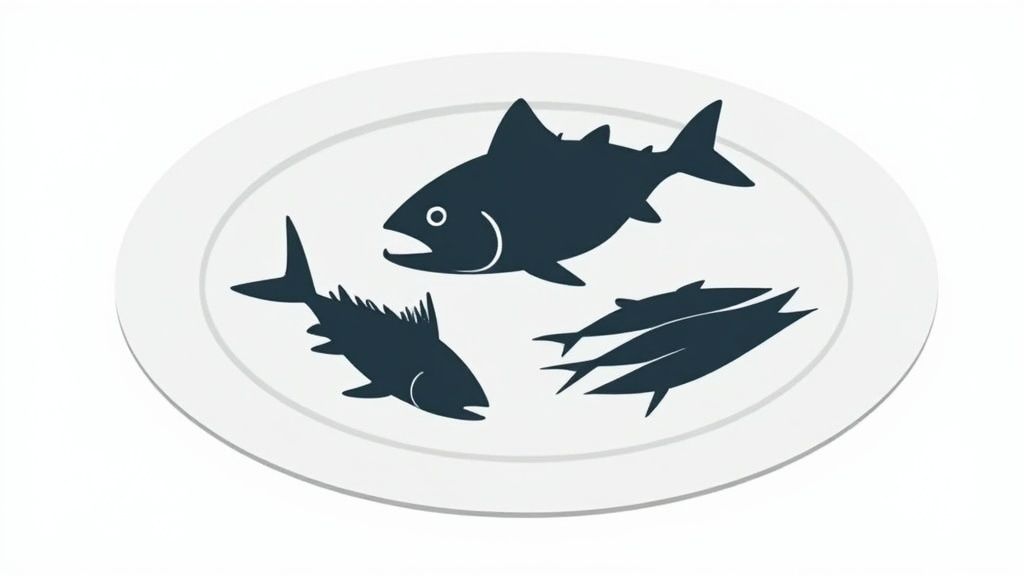8 Essential Low Fructose Food Staples for 2025

Struggling with fructose intolerance or simply trying to reduce your sugar intake can feel overwhelming. Many everyday 'healthy' foods, especially fruits and processed goods, are packed with fructose, making it difficult to know what's safe to eat. This guide simplifies everything. We've compiled a definitive list of essential low fructose food staples that are not only delicious and versatile but also packed with nutrients to support your health goals. Whether you're managing fructose malabsorption or just aiming for a healthier diet, these foods will form the reliable foundation of your meal planning.
This article cuts through the confusion, providing a clear, actionable roundup of dependable food choices. You will discover exactly which foods to embrace, from nutrient-dense avocados and leafy greens to satisfying options like aged cheeses and wild-caught fish. We’ll also touch on fruits like strawberries that you can enjoy in moderation. Each item on our list includes practical serving suggestions and nutritional insights, helping you build balanced and enjoyable meals.
Our goal is to give you a practical toolkit for navigating a low-fructose lifestyle with confidence. To make the process even smoother, we will demonstrate how to easily log and monitor these foods using the StopSugar app. This ensures you can track your progress and stay on target effortlessly, eliminating guesswork and helping you feel your best. Let's explore the foods that will become your new go-to staples for better health.
1. Avocados
Avocados are a fantastic low fructose food, often mistaken for a vegetable but botanically a fruit. They stand out because they contain a remarkably low amount of fructose, making them a safe and healthy choice for individuals managing fructose malabsorption or following a low-FODMAP diet. Rich in heart-healthy monounsaturated fats, fiber, and essential nutrients, they offer a creamy texture and satisfying flavor without the sugar load of other fruits.
Their versatility makes them an easy addition to any meal plan. You can use avocado to replace high-fructose ingredients, adding nutritional value and healthy fats that promote satiety and help stabilize blood sugar levels.
Nutritional Profile
A key reason avocados are a top-tier low fructose food is their macronutrient and micronutrient composition. They provide substantial fiber and potassium while keeping fructose to a minimum.
This bar chart visualizes the nutritional highlights of a 100g serving of avocado, focusing on its low fructose content compared to its high fiber and potassium levels.

The chart clearly shows that avocados deliver significant amounts of fiber and potassium with only a negligible 0.2g of fructose, confirming their status as a nutrient-dense, low-sugar option.
How to Use Avocados
Integrating avocados into your diet is simple and delicious. Here are a few practical ways to enjoy them:
- Breakfast Boost: Spread mashed avocado on toast as a substitute for butter or jam.
- Healthy Snack: Prepare a simple guacamole with lime juice, cilantro, and a pinch of salt to serve with low-fructose vegetable sticks like cucumbers or bell peppers.
- Smoothie Creamer: Use a quarter of an avocado to add creaminess to smoothies instead of high-fructose fruits like bananas.
- Salad Enhancer: Add sliced avocado to salads for a boost of healthy fats that will keep you full longer.
For a visual guide on picking the perfect avocado every time, check out this helpful video.
2. Leafy Green Vegetables (Spinach, Kale, Lettuce)
Leafy greens like spinach, kale, and lettuce are foundational to any low fructose food plan. These nutritional powerhouses are virtually fructose-free, containing less than 0.5 grams per 100g serving. This makes them an exceptionally safe choice for anyone with fructose malabsorption or those actively reducing their sugar intake on a low-FODMAP diet. They are packed with essential vitamins, minerals, and antioxidants without contributing to sugar-related symptoms.
Their versatility allows them to serve as the base for countless meals, from salads and smoothies to side dishes and wraps. By incorporating more leafy greens, you can easily displace higher-fructose ingredients while boosting your intake of fiber, which aids digestion and promotes a feeling of fullness.

Nutritional Profile
The primary reason leafy greens are a go-to low fructose food is their incredible nutrient density paired with negligible sugar content. They provide high levels of vitamins A, C, and K, as well as minerals like iron and calcium, all without the fructose load. Their low-calorie, high-fiber nature supports both digestive health and weight management.
This makes them a cornerstone for healthy eating, as recommended by nutrition experts like Dr. Terry Wahls and proponents of the Mediterranean diet. You can find more details about incorporating these greens into a sugar-conscious lifestyle by exploring this comprehensive list of sugar-free foods.
How to Use Leafy Green Vegetables
Adding leafy greens to your daily routine is simple and can transform your meals. Here are some practical ideas to get started:
- Lunch Base: Use baby spinach or mixed greens with an olive oil vinaigrette as the foundation for a filling, low-fructose salad.
- Dinner Side: Sauté kale with garlic and a splash of lemon juice for a quick and flavorful side dish that pairs well with lean proteins.
- Carb Swap: Use large lettuce leaves (like romaine or iceberg) as wraps for sandwiches or tacos instead of high-carb tortillas.
- Breakfast Addition: Wilt a handful of spinach into your scrambled eggs or omelet for an easy nutrient boost.
- Smoothie Filler: Add a cup of spinach or kale to your smoothies; its mild flavor is easily masked by other low-fructose ingredients like berries or avocado.
3. Wild-Caught Fish (Salmon, Cod, Sardines)
Wild-caught fish are an exceptional low fructose food because they are naturally free of any carbohydrates, including fructose. As pure protein and fat sources, options like salmon, cod, and sardines are ideal for those managing fructose malabsorption or following a low-FODMAP diet. They deliver high-quality protein and are packed with anti-inflammatory omega-3 fatty acids, which are crucial for brain health and reducing inflammation.
These fish provide a savory and satiating foundation for meals without adding any sugar. This makes them a perfect centerpiece for a diet aimed at stabilizing blood sugar levels and supporting overall digestive wellness.

Nutritional Profile
The primary benefit of wild-caught fish is its complete absence of fructose, combined with a high concentration of protein and omega-3 fatty acids. This nutrient-dense profile helps build lean muscle, supports cardiovascular health, and keeps you full, all without triggering fructose-related digestive issues.
Unlike plant-based foods, the focus here is on macronutrient quality. Wild-caught fish offer a clean, sugar-free source of energy and essential nutrients that are vital for a well-rounded, healthy diet.
How to Use Wild-Caught Fish
Incorporating these fish into your diet is straightforward and can be adapted to any meal. Here are some simple ideas:
- Simple Dinner: Grill or bake a salmon fillet and serve it with steamed, low-fructose vegetables like green beans or spinach.
- Quick Lunch: Mash canned sardines with avocado-oil mayonnaise and lemon juice, then serve on gluten-free crackers or cucumber slices.
- Gentle Meal: Prepare baked cod with herbs like dill and parsley for a light protein source that is easy on a sensitive stomach.
- Protein-Packed Salad: Top a bed of mixed greens with flaked canned tuna and a drizzle of olive oil and lemon juice.
When purchasing, look for certifications from sustainable sources like the Monterey Bay Aquarium Seafood Watch to ensure both quality and environmental responsibility. Aiming for two to three servings per week is an excellent goal for reaping the full health benefits.
4. Eggs
Eggs are an exceptional low fructose food, serving as a nutritional powerhouse with virtually zero fructose. They are one of the most complete and versatile protein sources available, making them a cornerstone for anyone managing fructose malabsorption or following a low-FODMAP, paleo, or keto diet. Packed with high-quality protein, healthy fats, and essential vitamins and minerals, eggs offer sustained energy without any sugar.
Their affordability and adaptability make them a simple choice for any meal. You can use eggs to create satisfying, protein-rich dishes that keep you full and help stabilize blood sugar, preventing the energy crashes associated with high-sugar foods.
Nutritional Profile
The primary reason eggs are a superior low fructose food is their composition: they are completely free of fructose while being rich in protein, choline, and vitamin D. Their balanced profile supports muscle repair, brain function, and overall health.
This makes eggs a perfect choice for starting the day or for a post-workout recovery meal, providing essential nutrients without any fructose-related digestive stress. Their complete absence of sugar and carbohydrates confirms their status as a pure protein and fat source.
How to Use Eggs
Incorporating this fantastic low fructose food into your daily routine is easy and beneficial. Here are several practical ways to enjoy them:
- Quick Breakfast: Prepare a simple scramble or a vegetable omelet with low-fructose vegetables like spinach and bell peppers.
- Grab-and-Go Snack: Hard-boil a batch of eggs at the beginning of the week for a convenient, high-protein snack.
- Satisfying Lunch: Make an egg salad using avocado mayonnaise and serve it with cucumber slices or on gluten-free bread.
- Balanced Dinner: Create a frittata loaded with low-fructose vegetables and a protein like chicken sausage for a meal that’s great for meal prep.
- Elegant Brunch: Serve poached eggs over a bed of sautéed greens or on a slice of gluten-free toast for a balanced and delicious meal.
5. Strawberries (Small Portions)
Strawberries are a delightful low fructose food option, but only when consumed in small, controlled portions. While they contain more fructose than options like avocados, their moderate level (around 2.4g per 100g) makes them one of the few common fruits that can be safely enjoyed by many on fructose-restricted diets. They are packed with antioxidants, vitamin C, and fiber, offering a sweet treat without the high sugar load of fruits like apples or mangoes.
Their inclusion in a low-fructose plan hinges on strict portion control. Adhering to recommended serving sizes, as outlined by experts like those at Monash University, allows individuals with fructose malabsorption to enjoy the taste and health benefits of berries without triggering digestive symptoms.
Nutritional Profile
The key to incorporating strawberries is understanding their fructose-to-glucose balance and overall sugar content. In small amounts, the fructose is manageable, and the fruit provides significant nutritional benefits, particularly a high concentration of Vitamin C.
A recommended serving size is typically around five medium strawberries (approximately 65g). This portion keeps the fructose intake low while still delivering valuable nutrients, making it a safe and popular choice within low-FODMAP guidelines.
How to Enjoy Strawberries
Careful portioning is essential for enjoying strawberries on a low-fructose diet. Here are some practical ways to include them:
- Yogurt Topper: Add five sliced strawberries to a bowl of Greek or lactose-free yogurt for a balanced breakfast or snack.
- Smoothie Addition: Blend a small portion into a smoothie with spinach, protein powder, and a low-fructose milk alternative.
- Sweet Treat: Pair a few fresh strawberries with a small amount of lactose-free cottage cheese or a handful of macadamia nuts.
- Healthy Dessert: For a simple frozen treat, blend frozen strawberries with a splash of lactose-free milk until it reaches an ice-cream-like consistency.
For those managing sugar intake, pairing fruits like strawberries with protein can be an effective strategy. Discover more about foods that cut sugar cravings to build a sustainable, healthy diet.
6. Aged Hard Cheeses (Cheddar, Parmesan, Swiss)
Aged hard cheeses are an excellent low fructose food, offering rich flavor and significant nutritional benefits without any fructose. Dairy products like cheese are naturally free of fructose, and the aging process for hard varieties like cheddar, parmesan, and Swiss breaks down almost all of the lactose (milk sugar). This makes them a safe and satisfying choice for individuals with fructose malabsorption or those following a low-FODMAP diet.
Their robust flavor profile and high protein and fat content make them a versatile ingredient. You can use aged cheeses to add depth to meals, boost satiety, and provide essential nutrients like calcium, all while avoiding hidden sugars common in many processed foods.
Nutritional Profile
The primary reason aged hard cheeses are a superior low fructose food is their complete absence of fructose combined with a high concentration of protein and calcium. The aging process, which can last from several months to years, ensures that any residual milk sugars are virtually eliminated.
This makes varieties like cheddar, Parmesan, and Swiss ideal for a low-sugar lifestyle. They provide a dense source of calories from protein and fat, helping to keep you full and satisfied between meals, which can be crucial for managing sugar cravings.
How to Use Aged Hard Cheeses
Incorporating aged hard cheeses into your diet is both easy and delicious. Here are a few practical ways to enjoy them:
- Protein-Rich Breakfast: Add shredded Swiss or cheddar cheese to your omelets or scrambled eggs for a savory, filling start to the day.
- Smart Snacking: Pair cubes of cheddar with low-fructose vegetables like cucumber or bell pepper sticks for a balanced and crunchy snack.
- Pasta Alternative: Grate Parmesan generously over zucchini noodles or spaghetti squash to create a classic Italian flavor without the high-carb, high-sugar pasta sauce.
- Flavor Enhancer: Use sharp, aged cheeses, as their strong flavor means you can use less while still getting a big taste impact, helping manage calorie intake.
7. Almonds and Almond Products
Almonds and their various products are an exceptional low fructose food, perfect for anyone managing their sugar intake. With just 0.05g of fructose per 100g, these nuts are a powerhouse of nutrition, offering healthy monounsaturated fats, protein, fiber, and vitamin E. This makes them a safe and versatile choice for low-fructose and low-FODMAP diets.
Their adaptability allows them to be used in countless ways, from whole nuts for snacking to almond flour for baking. Incorporating almonds can add texture, flavor, and significant nutritional value to your meals, helping you feel full and satisfied without the high sugar content found in other snacks.
Nutritional Profile
Almonds are a standout low fructose food due to their impressive nutritional density. They are packed with protein and fiber, which aid in satiety and digestive health, while containing virtually no fructose. This combination makes them ideal for maintaining stable energy levels.
Choosing almonds means you get a substantial nutrient boost without worrying about hidden sugars. Their rich profile supports overall health, from heart function to skin vitality, making them a smart addition to a balanced diet.
How to Use Almonds and Almond Products
Almonds are incredibly easy to incorporate into your daily routine. Here are some practical ideas:
- Simple Snack: Enjoy a small handful of 10-12 raw or dry-roasted almonds for a quick, satisfying snack.
- Breakfast Upgrade: Spread unsweetened almond butter on gluten-free toast or apple slices.
- Baking Alternative: Use almond flour as a low-fructose, gluten-free substitute for wheat flour in pancakes, muffins, and other baked goods.
- Dairy-Free Drink: Choose unsweetened almond milk for smoothies, coffee, or cereal to avoid the lactose and potential added sugars in other milks.
- Salad Topper: Sprinkle sliced or slivered almonds over salads for a nutritious crunch and a boost of healthy fats.
8. White Rice and Rice Products
White rice is an excellent low fructose food, serving as a fructose-free grain that provides easily digestible carbohydrates. It’s a foundational element for individuals managing fructose malabsorption or following a low-FODMAP diet because it doesn't trigger related digestive symptoms. As a versatile staple, white rice and its derivatives offer safe and satisfying carbohydrate options.
Products like rice noodles, rice cakes, and rice flour allow for great variety in a low-fructose meal plan. They provide the energy needed from carbohydrates without the digestive distress that high-fructose grains like wheat can cause, making them a reliable kitchen staple.
Nutritional Profile
The primary benefit of white rice is what it lacks: fructose. It is composed almost entirely of carbohydrates in the form of starch, with minimal fat and protein. This simple composition makes it a go-to energy source that is gentle on the digestive system for those with fructose intolerance.
While not a powerhouse of vitamins or fiber like brown rice, its low-irritant profile is precisely why it is recommended. It provides a neutral base for meals, allowing you to pair it with nutrient-dense proteins and low-fructose vegetables for a balanced and safe dish.
How to Use Rice and Rice Products
Incorporating rice into your diet is straightforward and offers many possibilities beyond just a side dish. Here are a few practical ways to enjoy it:
- Meal Base: Use steamed jasmine or basmati rice as a base for stir-fries, curries, or grilled proteins and vegetables.
- Quick Snack: Top plain rice cakes with almond butter or a slice of avocado for a fast, low-fructose snack.
- Pasta Alternative: Use rice noodles in Asian-inspired dishes like pho or pad thai to replace wheat-based pasta.
- Gentle Breakfast: Prepare a simple rice porridge (congee) with a low-fructose broth and top with scallions or ginger for a comforting start to the day.
- Baking Substitute: Use rice flour in gluten-free, low-fructose baking recipes for cookies, cakes, and muffins.
Cooking rice in larger batches is a great strategy for meal prepping, which can simplify your week. To explore how to integrate staples like rice into your planning, learn more about healthy meal planning on a budget.
Low Fructose Food Comparison Guide
| Item | Implementation Complexity 🔄 | Resource Requirements ⚡ | Expected Outcomes 📊 | Ideal Use Cases 💡 | Key Advantages ⭐ |
|---|---|---|---|---|---|
| Avocados | Moderate - ripening and storage | Medium - needs seasonal availability | Low fructose, high healthy fats and fiber | Low-FODMAP diets, fat source, weight management | Very low fructose, heart health support |
| Leafy Green Vegetables | Low - simple prep (raw or cooked) | Low - affordable, widely available | Virtually no fructose, rich vitamins & fiber | Daily low-fructose meals, anti-inflammatory | Extremely low fructose, versatile |
| Wild-Caught Fish | Moderate - sourcing & handling | Medium to high - cost and freshness | Zero fructose, high omega-3 protein source | Fructose-free protein, anti-inflammatory diet | Fructose-free, omega-3 rich |
| Eggs | Low - quick and easy | Low - affordable and common | Zero fructose, complete protein & nutrients | Any meal, quick protein, muscle maintenance | Fructose-free, versatile, nutrient-dense |
| Strawberries (Small Portions) | Low - portion control required | Low to medium - seasonal freshness | Moderate fructose with antioxidants | Controlled sweet fruit intake, low-FODMAP treat | Low fructose for fruit, antioxidant-rich |
| Aged Hard Cheeses | Low - ready to eat | Medium - cost and storage | Zero fructose, high protein and calcium | Low-fructose snacking, keto, bone health | Fructose-free, highly satiating |
| Almonds and Almond Products | Low - portion control | Medium - expensive nut products | Very low fructose, rich in healthy fats | Snacks, baking, low-FODMAP substitutions | Extremely low fructose, heart health benefits |
| White Rice and Rice Products | Low - simple cooking required | Low - affordable staple | Zero fructose, digestible carbs | Grain substitute for low-FODMAP diets | Fructose-free, widely available, versatile |
Build Your Fructose-Friendly Pantry with Confidence
Navigating the world of nutrition can feel overwhelming, but building a diet around low fructose food doesn't have to be complicated. As we've explored, creating a satisfying and health-conscious lifestyle is entirely achievable by focusing on a core set of versatile, nutrient-dense staples. From the creamy richness of avocados and the lean protein of wild-caught salmon to the simple reliability of eggs and white rice, you now have a foundational blueprint for your meals.
This journey is about empowerment, not restriction. By embracing these eight food groups, you're taking a significant step toward stabilizing your energy levels, improving your mood, and gaining long-term control over your health. You are building a sustainable framework that works with your body, not against it.
Your Actionable Next Steps
To turn this knowledge into lasting habits, focus on these practical strategies:
- Start with One Meal: Don't try to overhaul your entire diet overnight. Begin by transforming just one meal a day, like breakfast. Swap your usual sugary cereal or fruit-heavy smoothie for a savory scramble with spinach, avocado, and a side of strawberries.
- Plan and Prep: Success is born from preparation. Dedicate a few hours each weekend to plan your meals and prep key ingredients. Cook a batch of white rice, hard-boil some eggs, and wash your leafy greens. Having these components ready to go makes healthy choices effortless during a busy week. For effective meal prep and storage, you might find a useful guide to collapsible silicone food containers from HYDAWAY, which can help keep your low-fructose ingredients fresh and organized.
- Track and Learn: Knowledge is power. Use the StopSugar app to log your meals and track your mood. This simple daily practice will reveal powerful connections between what you eat and how you feel, providing the personalized data you need to fine-tune your approach. The app’s ‘Panic Button’ is also an invaluable tool for those moments when cravings hit, offering immediate, safe alternatives to keep you on track.
Embrace a Sustainable Path Forward
Adopting a low-fructose lifestyle is a powerful investment in your well-being. It’s about creating a new normal where you feel vibrant, focused, and in command of your health. The foods we’ve covered are not just items on a list; they are the building blocks of a more resilient you.
By stocking your kitchen with these staples and leveraging tools like the StopSugar app, you are setting yourself up for success. You are creating an environment where healthy decisions are the easiest ones to make. Download the app today, start building your personalized plan, and confidently step into a healthier, more energized future.